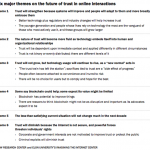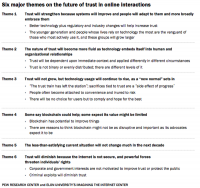the highest Three online security Menaces You will have to worry About In 2016
Smartphones and a profusion of related devices will be high looking floor for hackers. And Apple products usually are not immune.
December 23, 2015
it can be arduous to know what the future will carry—except you are talking about online security. “We rarely see things that just kind of appear out of nowhere,” says Ryan Olson, intelligence director at enterprise safety company Palo Alto Networks.
folks will proceed to be ill-prepared since the caution and vigilance—verging on paranoia—that are required to be safe online are usually not in most folks’ nature. “we are conditioned to be social, to collaborate,” says Geoff Webb, a VP at safety firm Micro center of attention, which focuses on preventing security breaches. “These are all just right issues . . . but they are completely, ruthlessly, and vigorously exploited by attackers.” Governments and entrepreneurs can exploit too, he warns.
We requested Olson, Webb, and Ondřej Vlček, COO of antivirus maker Avast, what new or growing risks the public should be careful for in 2016. Three rose to the highest: assaults on smartphones, ransomware that holds information or devices hostage, and leaks from new linked devices like TVs and home automation systems.
telephones Are changing PCs As the number one goal
“it can be fascinating to look how the dangerous guys are shifting from the pc environment, like the standard viruses, the malware [malicious software] on windows, or maybe on Mac,” says Vlček, “and more toward the cellular environment.” mobile malware is progressing from isolated or theoretical to in style and dangerous, especially on Apple’s iOS operating device, says Olson.
for example, Apple has opened up a software permitting companies to create apps for their staff directly, while not having to move in the course of the App store. Stealing or forging digital paperwork referred to as certificates, which convey that the app is from a relied on source, makes it more straightforward to get malware onto devices. the risk has been around for a couple of years, says Olson, nevertheless it used to be first exploited in 2015 with a family of malware referred to as WireLurker. Hackers are tricking telephone homeowners on more than a few systems, too. as an example, they provide apps or hyperlinks to web sites that promise methods to unencumber new levels in video games like reduce The Rope or Temple Run without paying, says Vlček. Clicking on mobile pop-up commercials is a approach to begin downloads of those apps, says Olson.
Ransomware Is Locking Up more valuable data
a glance via security headlines in 2014 and 2015 turns up references to a boom in ransomware, including CryptoWall and CryptoLocker. These are sorts of malware that infect PCs and Macs the way other baddies do, thru bogus attachments or hyperlinks or infected websites. As with different malware, these assaults are also shifting to cell units, says Olson. some of the earliest used to be SimpleLocker, which started to infect Android units in 2014.
somewhat than wreck or steal information, ransomware encrypts it, and then crooks demand payment to free up the information. this is more revolutionary than an attack like stealing a credit card quantity, says Olson, as a result of crooks should not have to fret about anti-fraud measures that forestall them from using the card, nor do they’ve to go throughout the “cashing out” process of buying one thing with the stolen card info, having it shipped somewhere, after which promoting it. These are all alternatives to get caught.
as an alternative, they ask for payment during the difficult-to-trace Bitcoin cryptocurrency. The crooks have to provide “customer service,” as Olson calls it, teaching victims the right way to arrange and use Bitcoin. In 2016, he expects crooks to make more cash with the aid of focused on in point of fact precious information belonging to people and firms that can pay more. “i feel what we will see is ransomware that looks for file varieties that belong to really specialised tool, he says. “They could be ready the place it’s worthwhile for a company to pay 50 grand to get back these information.”
linked gadgets Are Spilling information
The internet of issues (IoT) contains the profusion of devices and machines related to the digital world—health bands, smart TVs, baby monitors, smart thermostats, connected cars, and rather more. “That implies that the assault surface of our lives is growing extraordinarily rapidly,” says Webb, the usage of a popular piece of lingo amongst security pros. “many of the corporations and engineers do not truly take into accounts safety,” says Vlček. data, as an instance, is incessantly transmitted without any encryption, making it simple to steal or fiddle with.
A string of vulnerabilities within the routers and other hardware that move web traffic increases the chance. “the safety scenario with [home] routers is if truth be told beautiful unhealthy,” says Vlček, noting that 2015 noticed with the aid of far essentially the most attacks on routers. These devices are frequently left in the manufacturing facility setup with default usernames and passwords that someone can look up on-line. like all online devices, routers have safety flaws that emerge, requiring patches to their running packages, called firmware. “many of the companies do a reasonably just right job of . . . patching the vulnerabilities,” says Vlček. “however the problem is that no person updates the firmware in the routers. The user doesn’t at all, and regularly the ISP doesn’t both.”
simply what attackers will do with this get right of entry to is not clear. “we are within the phase where attackers are roughly taking part in with these units as an alternative of posing a real threat,” says Vlček. however nightmare scenarios are lots. In summer season 2015, hardware hackers Charlie Miller and Chris Valasek discovered and publicized a vulnerability in Chrysler-Fiat’s Uconnect device that allowed them to get right into a Jeep’s onboard leisure system over the internet, and from there, keep watch over crucial elements such because the accelerator, brakes, and transmission—a vulnerability that Vlček calls ludicrous. It gets even scarier with self-driving automobiles, though now not but, says Olson. “i do not expect there to be a military of self-driving vehicles [in 2016] which are taken over by way of attackers,” he says. “that’s most definitely 10 years away.”
Webb issues more concerning the lack of privacy with the IoT. “it’s like portray a picture with little dots of knowledge,” he says. “some of that is lightbulbs going on and off in your home. a few of it’s, where is your automobile, and some of it is where is your cellphone. it can be, is your television on presently? And some of it is, what’s taking place at your entrance door? And, what’s your fridge announcing?” even if all this information is anonymized (which Webb fears it is not going to be), it starts to build an identifiable profile of an individual, a body of metadata analogous to that accumulated through the NSA from phone call data, however a long way more in depth, says Webb. He admits now not having a clear prediction of what’s going to happen with the info, however he expresses suspicion of both marketers and governments.
The problem with the IoT, and all online products and services, is that it is so appealing to feed them information in alternate for comfort. “the world goes to reply to you in a method that’s incredibly situated round your needs and desires,” Webb says. “[Online services] will just recognize when to order a pizza, because you frequently order pizza after you go to the health club, and you will have been there 3 times this week. that is simply superior. The challenge, the draw back of that’s, you gain quite a few worth, but you lose various keep an eye on over information about yourself.”
(5)






